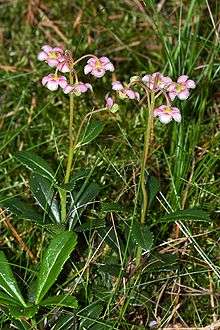Chimaphila umbellata
Chimaphila umbellata, the umbellate wintergreen, pipsissewa, or prince's pine, is a small perennial flowering plant found in dry woodlands, or sandy soils. It is native throughout the cool temperate Northern Hemisphere.
| Chimaphila umbellata | |
|---|---|
 | |
| Scientific classification | |
| Kingdom: | Plantae |
| Clade: | Tracheophytes |
| Clade: | Angiosperms |
| Clade: | Eudicots |
| Clade: | Asterids |
| Order: | Ericales |
| Family: | Ericaceae |
| Genus: | Chimaphila |
| Species: | C. umbellata |
| Binomial name | |
| Chimaphila umbellata | |
It grows 10–35 cm tall, and has evergreen shiny, bright green, toothed leaves arranged in opposite pairs or whorls of 3–4 along the stem. Leaves have a shallowly toothed margin, where the teeth have fine hairs at their ends. The flowers are white or pink, produced in a small umbel of 4–8 together.
Ecology
Although it has green leaves year-round, it receives a significant portion of its nutrition from fungi in the soil (that is, it is a partial myco-heterotroph, which is not surprising as related plants, such as Pyrola, are partial or full myco-heterotrophs).[1]
Taxonomy
There are four subspecies:
- Chimaphila umbellata subsp. umbellata – Europe, Asia
- Chimaphila umbellata subsp. acuta – southwestern North America
- Chimaphila umbellata subsp. cisatlantica – northeastern North America
- Chimaphila umbellata subsp. occidentalis – northwestern North America
Uses
Some Plateau Indian tribes used a boil of prince's pine to treat tuberculosis.[2]
The twentieth century Appalachian folk healer Clarence "Catfish" Gray, "Man of the Woods", credited pipsissewa with curing his own heart problems and included it in his 15 herb cure-all "bitters."[3]
It is used as a flavoring in candy and soft drinks, particularly root beer.
The roots and leaves of Chimaphila umbellata can be boiled to create tea.[4]
Name
"Pipsissewa" is a Cree name meaning "It-breaks-into-small-pieces".
| Wikimedia Commons has media related to Chimaphila umbellata. |
References
- Leho Tedersoo; Prune Pellet; Urmas Kõljalg; Marc-André Selosse (March 2007). "Parallel evolutionary paths to mycoheterotrophy in understorey Ericaceae and Orchidaceae: ecological evidence for mixotrophy in Pyroleae". Oecologia. 151 (2): 206–217. Bibcode:2007Oecol.151..206T. doi:10.1007/s00442-006-0581-2. PMID 17089139.
- Hunn, Eugene S. (1990). Nch'i-Wana, "The Big River": Mid-Columbia Indians and Their Land. University of Washington Press. p. 352. ISBN 978-0-295-97119-3.
- Green, E. (1978). "A Modern Appalachian Folk Healer". Appalachian Journal. 6 (1): 2–15.
- Patterson, Patricia A. (1985). Field Guide to the Forest Plants of Northern Idaho (PDF). United States Department of Agriculture Forest Service. p. 37-47.
